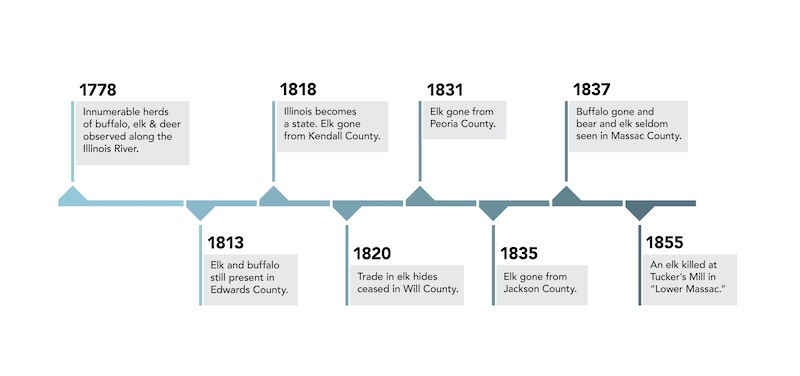
Photo by Michael Jeffords.



Photo by Michael Jeffords.
A wild elk on a recent walkabout in Illinois was briefly a celebrity and a reminder of times past. Elk (Cervus canadensis) are known by many names, including stag, cerfs, Wapiti, Heȟáka, Omashkooz and numerous others. In a group, elk are typically called a herd, but they may also be referred to as a gang. It has been a very long time since an elk herd roamed through Illinois, making this lone elk one worthy of writing a story about.
According to Hoffmeister, in his book Mammals of Illinois, Father Marquette’s exploration party in 1673 found elk to be common along the Illinois River, and reports from other explorers later in the 1700s indicate that elk were still common at that time in the land now known as Illinois. That had changed by the 1800s. Illinois became a state in 1818 and elk were already rare. Hoffmeister reported that elk were uncommon and nearly gone from the northern part of the state by the 1820s and in the southern part of the state by the 1830s.

Today, there are no wild populations of elk in the Prairie State. While there are captive elk in the state owned by private landowners, those animals are not managed by the Illinois Department of Natural Resources (IDNR). And elk are not currently protected by the Illinois Wildlife Code.
In the fall, bull elk are focused on finding mates. Less dominant males, without hope of breeding with local females, often travel in their quest to procreate. Some travel farther than others.
From September to December 2023, a young bull elk from the Wisconsin Black River Falls herd made a historic journey, traveling through southeastern Wisconsin and into northern Illinois. This was the first documented wild elk in Illinois in more than 150 years.

Biologists from the Wisconsin Department of Natural Resources (DNR) had been in communication with the IDNR about the 3½ year old elk. The Wisconsin DNR had tagged the elk, ear tag number 357, as a calf and had been monitoring his journey through Wisconsin. He was first reported in Illinois during the second deer firearm season (November 30-December 3, 2023) and recorded on several field cameras, including one set up near Pecatonica in Winnebago County. The elk then headed south, with a photo-documented sighting near Newark in Kendall County.
On December 13, 2023, his almost 300-mile journey ended abruptly as the Illinois State Police and Illinois Department of Transportation (IDOT) confirmed that the elk was struck and killed on southbound Interstate 55 just before the exit ramp to Interstate 80. An IDOT maintenance crew removed the roughly 600-pound carcass using large heavy equipment. Because the elk was a tagged wild animal, the carcass was released to the IDNR.
Wisconsin Public Radio reported that elk 357 started his ill-fated trek back in September 2023, when the Wisconsin Department of Natural Resources started to get reports of the bull turning up in unusual places, including in towns and on major roadways. The elk became a local celebrity of sorts in Wisconsin, travelling from his natal place to rural Marathon County, then through the Wausau area, northwest to Taylor County, walking south through Columbia County and finally ending up near Madison, Wisconsin, before crossing the invisible state border into northern Illinois.

This elk started life in Jackson County, Wisconsin, as part of the Black River Falls herd. As in Illinois, elk had been extirpated in Wisconsin by the 1880s. Reintroduction efforts in Wisconsin started in 1989. The first elk reintroduction there occurred in May 1995. Biologists released 25 elk in the Great Divide District of the Chequamegon-Nicolet National Forest near Clam Lake. In 2015 and 2016, 73 elk from southeastern Kentucky were released in eastern Jackson County, Wisconsin, creating the Black River Falls herd. In 2017 and 2019, biologists released 91 elk on the Flambeau River State Forest in Sawyer County to increase herd numbers and supplement the genetic variation of the Clam Lake population.
Because the elk came from a Chronic Wasting Disease (CWD) positive county in Wisconsin and made its way through several CWD positive counties in Illinois, IDNR biologists are testing the remains.
Elk #357 came to an untimely end, but it is possible that we’ll see other male Wisconsin elk make similar journeys in the future. Elk prefer open woodlands near grasslands. In Illinois, a population of elk would have the best chance of surviving in southern Illinois or in select areas along the Mississippi or Illinois Rivers. For those who are curious, the IDNR has no current plans to reintroduce elk into Illinois due to low stakeholder buy-in and the potential threat posed by Chronic Wasting Disease.
If you are ever lucky enough to see a light tan-colored animal that’s about three times larger than a white-tailed deer with a dark brown mane on the neck and a distinct buff-colored rump patch, take a photo (from a safe distance of course!). As with any large animal, it is wise to respect an elk’s space, since bull elk can weigh 600-900 pounds and stand 5 feet or more at the shoulder. If another wild elk gets as far as Illinois it will need people to give it space so that it can attempt to navigate our maze of roads and highways during its walkabout.
Laura Kammin is a Natural Resources Specialist with the National Great Rivers Research and Education Center. She formerly held positions at Illinois-Indiana Sea Grant, University of Illinois Extension, Prairie Rivers Network and the Illinois Natural History Survey. She received her master’s degree in wildlife ecology from the University of Illinois, Urbana-Champaign.
Submit a question for the author